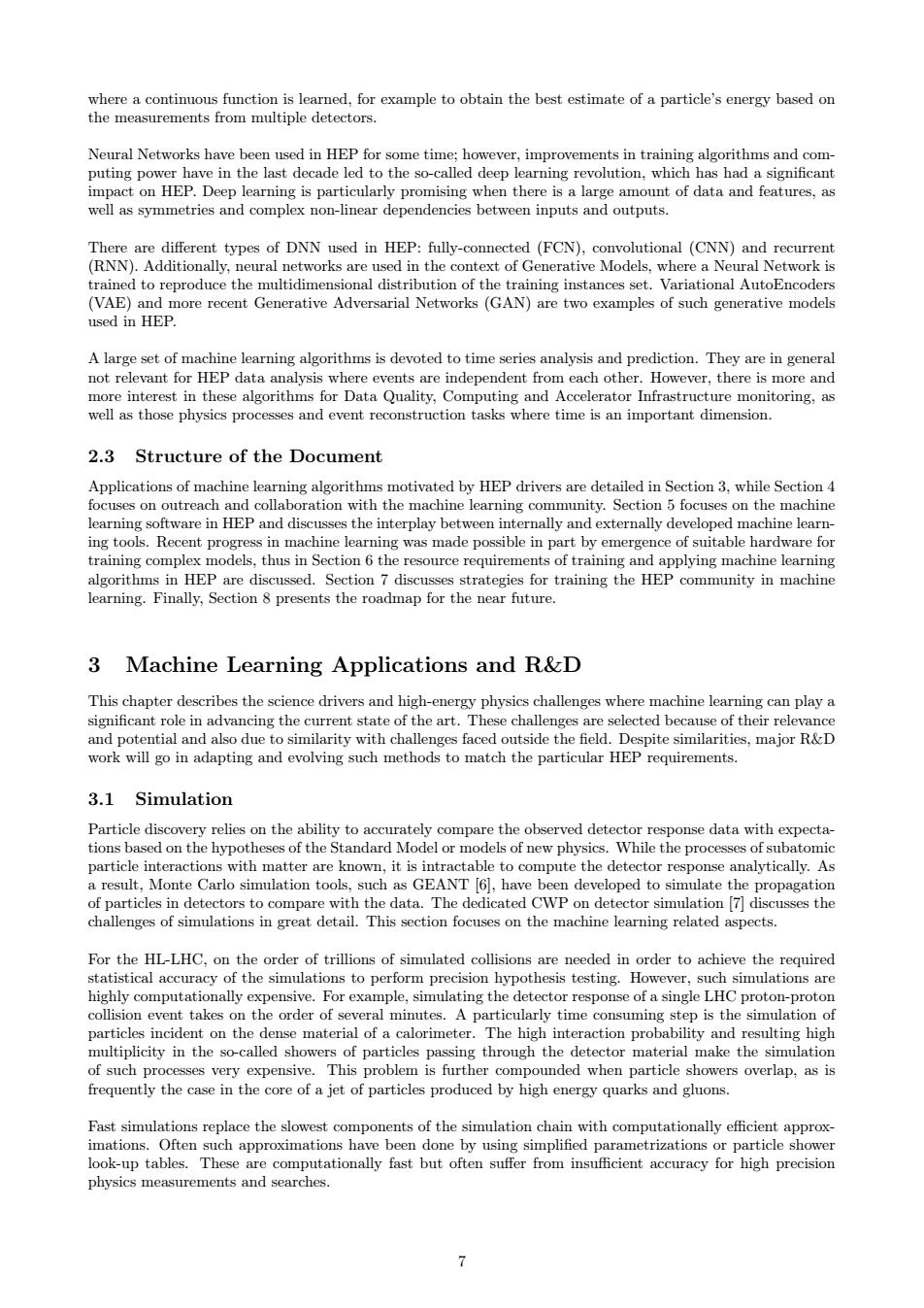正在加载图片...

oforee toobain the bet ete of partice'ybdo impact on HEP.Deep learning is particularly promising when there is a large amount of data and features,as well as symmetries and complex non-linear dependencies between inputs and outputs There are different types of DNN used in HEP:fully-connected(FCN),convolutional (CNN)and recurrent (RNN).etworks aresd in the co work is used in HEP. A large set of machine learning algorithms is devoted to time series analysis and prediction.They are in general not relevant for HEP data an alysis where event s are independent from eachother.However,there is more and 2.3 Structure of the Document earning software in HEP and discusses the interplay between internally and developed machine lear ing tools Recent ng was made p t by emerg learning.Finally,Section 8 presents the roadmap for the near future. 3 Machine Learning Applications and R&D This chapter describes the science drivers and high-energy physics challenges where machine learning can play a work will go in adapting and evolving such methods to match the particular HEP requirements. 3.1 Simulation ctions with matter are known,it is int acta cated CWP challenges of simulations in great detail.This section focuses on the machine learning related aspects For the HLLHC.on of trillions of simulated ded in r example,simula tector response of a single LH oton-proto icity in the part case in the core of a jet of particles produced byhigh guo Fast simulation place the slo utationally efficient mations.Often such approximations have been done by using simplified parametrizations or particle shower These are computationally fast but often suffer from insufficient accuracy for high precision 7 where a continuous function is learned, for example to obtain the best estimate of a particle’s energy based on the measurements from multiple detectors. Neural Networks have been used in HEP for some time; however, improvements in training algorithms and computing power have in the last decade led to the so-called deep learning revolution, which has had a significant impact on HEP. Deep learning is particularly promising when there is a large amount of data and features, as well as symmetries and complex non-linear dependencies between inputs and outputs. There are different types of DNN used in HEP: fully-connected (FCN), convolutional (CNN) and recurrent (RNN). Additionally, neural networks are used in the context of Generative Models, where a Neural Network is trained to reproduce the multidimensional distribution of the training instances set. Variational AutoEncoders (VAE) and more recent Generative Adversarial Networks (GAN) are two examples of such generative models used in HEP. A large set of machine learning algorithms is devoted to time series analysis and prediction. They are in general not relevant for HEP data analysis where events are independent from each other. However, there is more and more interest in these algorithms for Data Quality, Computing and Accelerator Infrastructure monitoring, as well as those physics processes and event reconstruction tasks where time is an important dimension. 2.3 Structure of the Document Applications of machine learning algorithms motivated by HEP drivers are detailed in Section 3, while Section 4 focuses on outreach and collaboration with the machine learning community. Section 5 focuses on the machine learning software in HEP and discusses the interplay between internally and externally developed machine learning tools. Recent progress in machine learning was made possible in part by emergence of suitable hardware for training complex models, thus in Section 6 the resource requirements of training and applying machine learning algorithms in HEP are discussed. Section 7 discusses strategies for training the HEP community in machine learning. Finally, Section 8 presents the roadmap for the near future. 3 Machine Learning Applications and R&D This chapter describes the science drivers and high-energy physics challenges where machine learning can play a significant role in advancing the current state of the art. These challenges are selected because of their relevance and potential and also due to similarity with challenges faced outside the field. Despite similarities, major R&D work will go in adapting and evolving such methods to match the particular HEP requirements. 3.1 Simulation Particle discovery relies on the ability to accurately compare the observed detector response data with expectations based on the hypotheses of the Standard Model or models of new physics. While the processes of subatomic particle interactions with matter are known, it is intractable to compute the detector response analytically. As a result, Monte Carlo simulation tools, such as GEANT [6], have been developed to simulate the propagation of particles in detectors to compare with the data. The dedicated CWP on detector simulation [7] discusses the challenges of simulations in great detail. This section focuses on the machine learning related aspects. For the HL-LHC, on the order of trillions of simulated collisions are needed in order to achieve the required statistical accuracy of the simulations to perform precision hypothesis testing. However, such simulations are highly computationally expensive. For example, simulating the detector response of a single LHC proton-proton collision event takes on the order of several minutes. A particularly time consuming step is the simulation of particles incident on the dense material of a calorimeter. The high interaction probability and resulting high multiplicity in the so-called showers of particles passing through the detector material make the simulation of such processes very expensive. This problem is further compounded when particle showers overlap, as is frequently the case in the core of a jet of particles produced by high energy quarks and gluons. Fast simulations replace the slowest components of the simulation chain with computationally efficient approximations. Often such approximations have been done by using simplified parametrizations or particle shower look-up tables. These are computationally fast but often suffer from insufficient accuracy for high precision physics measurements and searches. 7